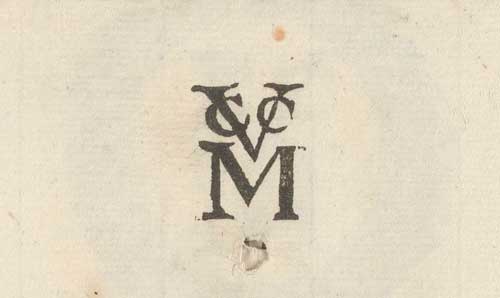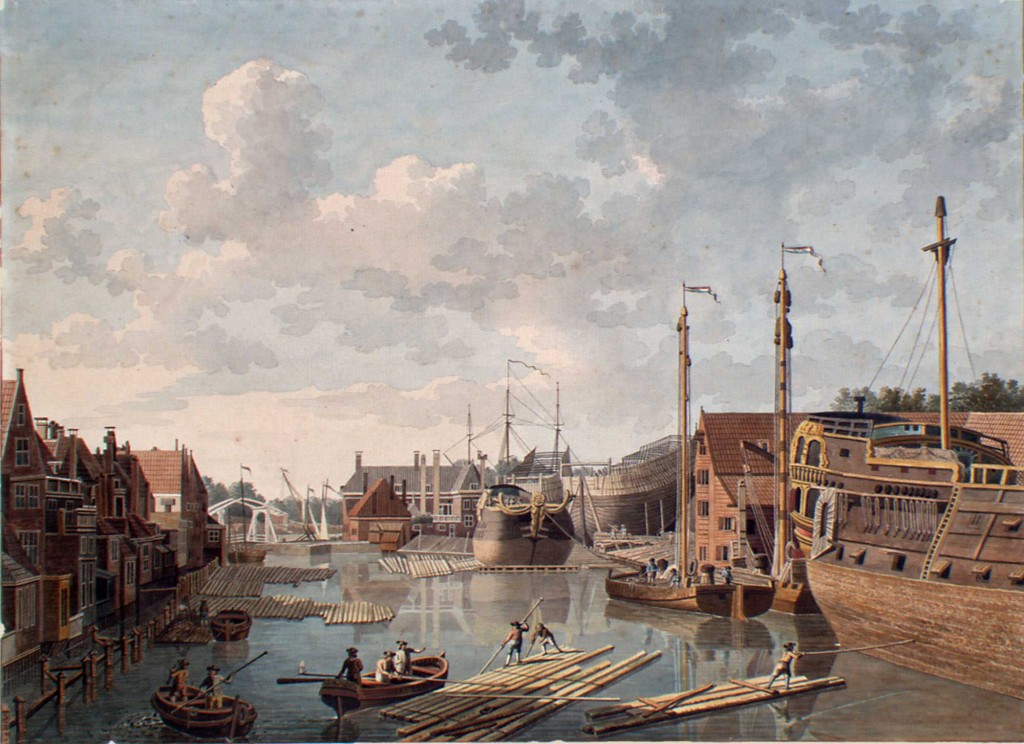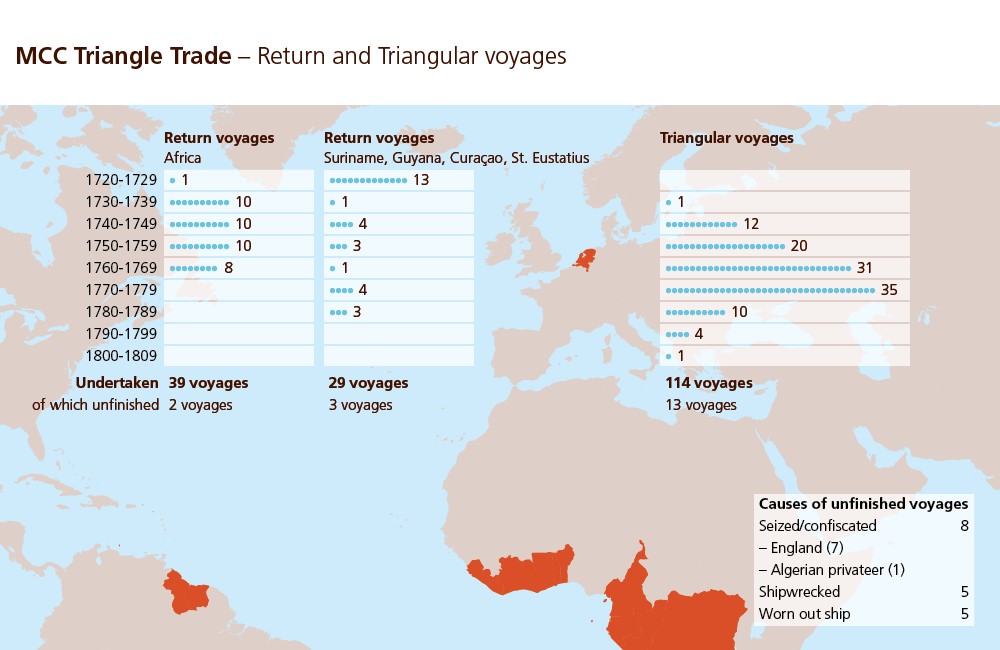The Middelburgse Commercie Compagnie (MCC) was a Dutch private commercial enterprise founded in 1720. In addition to trade with the ports of the Baltic Sea and Mediterranean Sea, the MCC was also involved with the triangular, or trans-Atlantic slave trade.
On a trans-Atlantic slave voyage, ships left the European homeport loaded with cargo (trading goods) for the coast of West-Africa. There, these goods were traded for enslaved Africans, ivory and gold. The ship would then sail across the Atlantic Ocean to the colonies in North- and/or South-America.
There, the Africans were sold either at public auctions, or privately to plantation owners. They faced a future of enslavement, working on one of the many sugar, coffee, tobacco and cotton plantations. The ships returned home to Europe, loaded with plantation produce.
MCC or CCM?
The MCC was founded in 1720 as the ‘Commercial Company of the city of Middelburg’, or CCM. However, with the archives inventory published in 1950, the company became known as the Middelburgse Commercie Compagnie.
Economy and War
The economic Golden Age of the Republic occurred between 1595 and 1675, with a stable trade until 1700. Towards the start of the 18th century however, it began to stagnate, partly due to European Wars, such as the nine-year war (1688-1697) and the War of the Spanish Succession (1701-1713). Still, the country did not lack for funds, mostly because the privateers ran rampant during the above mentioned wars – capturing and selling enemy ships with permission of the government.
The Republic and Middelburg
The role of the Republic as an international player had decreased in the 18th century. Within the Republic, it was the province of Holland, with its port of Amsterdam, which prevailed. Middelburg had already lost its position as second port of the Republic to Rotterdam. Therefore, in 1720 the city attempted to stimulate the trade by founding two companies: the Middelburgse Assurantie Compagnie (an insurance company based on Amsterdam example), and the MCC.
Stockjobbing
The MCC was found in 1720: the year of stockjobbing. Thanks to the privateers, a lot of funds were available. However, after the end of the Spanish War of Succession, the possibilities of privateering as a source of profit and as an investment was considerably reduced. Many rogue entrepreneurs founded fake companies, collected the investors’ money and disappeared.
Middelburg and the MCC
Middelburg embraced the founding of the MCC, since the company would be based in the city – the city council would have had a high estimation of the possible economic advantages to the city. In addition, the lord governors planned to become shareholders themselves, as can be seen from the signatures of the founding charter. The ties between the city and the new company were strong.
After the city had approved the founding, the MCC was able to raise funds of five million guilders, put in by 587 investors. The stockjobbing in the year 1720 however, messed things up: many investors encountered problems and had to reduce or entirely withdraw their input. The final amount raised was a little less than 1.4 million guilders.
The board of directors
The first board consisted of three members of the Middelburg city council and two merchants. It was decided that only chief participants could take part in the board. At first, these participants were those who had invested 6.000 guilders or more – later this was reduced to 3.000 guilders. In addition, future directors had to have been investors for at least two years, and be residents of Middelburg.
The chief participants chose 16 commissioners. They in turn elected some men from the group for:
- checking the account books
- approving and clearing the transaction and written accounts of the directors
- reporting their findings to the chief participants
The board met at the Balans. This probably happened initially in a meeting room in the St. Jorisdoelen and then in its own building on the Balans. Behind this building was a large MCC warehouse. The premises of the civic guard of St. Joris included several rooms which, in addition to being used for meetings, were also used for a variety of auctions, such as inheritances.
Specializing in human trafficking
The MCC was involved with markets all over the world from the very beginning. Summarized geographically, from north to south: the Strait of Davis (whaling), ports on the North Sea (for example in France), ports on the Baltic Sea, ports on the Mediterranean Sea, via and across the Atlantic Ocean to the coast of West Africa, and ports in Guyana and the Caribbean. There was even a voyage to the Pacific Ocean, and another to Java in East India.
The first transatlantic voyage of the MCC left Middelburg in 1732. The monopoly to the transatlantic trade in enslaved Africans had belonged to the West Indian Company (WIC) until 1730, after which this semi-state company released its monopoly on the trade. On condition of paying an ‘acknowledgement fee’, private companies such as the MCC could start trading in enslaved Africans.
The triangular voyages of the MCC went to the Windward Coast (roughly modern-day Liberia and Cote d’Ivoire), the Gold Coast (modern-day Ghana) and the Loango-Angola coast (modern-day Congo and north Angola). From there the ships left for Guyana (Suriname, Berbice, Essequibo and Demerary) or to St. Eustatius and Curacao. The destinations at the Windward Coast were characteristic of the MCC trade in enslaved people.
Heyday and Abolition
The trade in enslaved Africans increased gradually until 1756, at which time the company decided to specialize in the slave trade. Between 1756 and 1807 the MCC sent out 92 triangular voyages and 22 other voyages. As far as is known, the company prepared 114 triangle voyages during the eighteenth century, out of a total of 296 voyages.
In 1807, the United Kingdom abolished the transatlantic trade in enslaved people. Due to all the wars, the Dutch triangle trade had by this time already come to a standstill, and the colonies of the Republic had been a British mandate since 1795. The English Abolition meant a definite end of the trade, although it would be another seven years before the trade would be forbidden by the Netherlands as well.
Wars in the 18th century and the beginning of the 19th century:
- Spanish War of Succession, 1701-1713
- Austrian War of Succession, 1740-1748
- Seven Year War, 1756-1763
- Fourth Anglo-Dutch War, 1780-1784
- Coalition Wars, 1792-1802
- Napoleonic Wars, 1804-1815
Even though the Republic of the Seven United Netherlands had existed as the Batavian Republic since 1795 and despite being uninvolved with the above-mentioned wars, trade was disrupted. The fourth Anglo-Dutch War was especially damaging for the MCC – a few MCC ships were yielded to England. The Napoleonic Wars even brought the trading activities to a complete standstill.
The MCC in the 19th century
The nature of the company underwent a drastic change in the 19th century – it focused chiefly on the construction of ships for other companies. At the start of the century, the shipyard of the by now abolished Dutch East India Company was acquired, prompting the board to move from the Balans to their new shipyard. In this new phase, the MCC would build 30 ships, including ships for the navy, the Nederlandse Handelsmaatschappij (Dutch Trading Society), the steamboat traffic between Flushing and Breskens, and the steamboat traffic between Middelburg and Rotterdam. In the second half of the 19th century, the company attempted to specialize in repairing iron ships. A futile effort: in 1889 the curtain official dropped for the MCC.



Balkengat in Middelburg, 1778
Shipyard of the Dutch East India Company, chamber of Zeeland in Middelburg. Next to the shipyard of the DEIC lay those of the Dutch West India Company and the MCC. Jan Arends, 1778, drawing, 30×41.3 cm. Zeeland Archives, Royal Zeeland Society of Sciences, Zeelandia Illustrata II, inv.nr 460.


